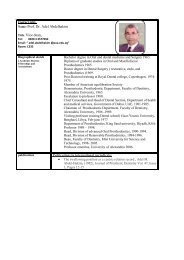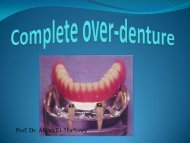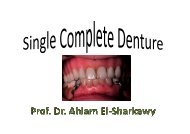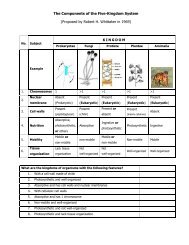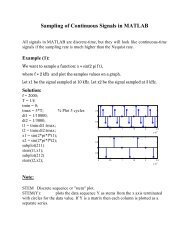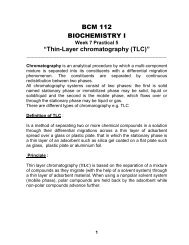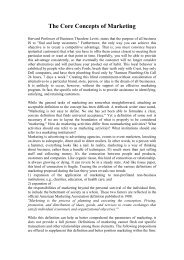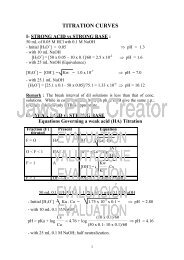Definition
Definition
Definition
Create successful ePaper yourself
Turn your PDF publications into a flip-book with our unique Google optimized e-Paper software.
definition<br />
Types of<br />
Retention<br />
Types of Direct<br />
Retainers
<strong>Definition</strong>:<br />
Is that quality inherent in the<br />
prosthesis acting to resist the<br />
forces of dislodgment along<br />
the path of placement
Direct Retainers<br />
Indirect Retainers<br />
Frictional fit between<br />
Natural & Artificial teeth<br />
The use of undercut areas<br />
on the teeth & soft tissue<br />
Physical factors of<br />
Retention
Internal<br />
Attachment<br />
Clasps<br />
Precision &<br />
Semipercision<br />
Intracoronal<br />
&<br />
Extracoronal
Attachments:<br />
Ready made pairs of male and female parts, part<br />
fixed to natural teeth, and part attached to<br />
denture<br />
Advantages:<br />
1. No buccal & labial clasp arm<br />
2. It is less stressful to the abutment than<br />
clasps<br />
3. The efficiency of retention is not affected by<br />
contour of the abutment<br />
4. More tolerated by the patient than clasps<br />
5. Hygienic
Disadvantages:<br />
1. It require prepared abutments and<br />
casting<br />
2. It require complicated clinical &<br />
laboratory procedures<br />
3. It eventually wear , resulting loss of fit<br />
4. Difficult to repair & replace<br />
5. Expensive
A Clasp is a metal component of<br />
a partial denture engages the<br />
external surface of an<br />
abutment aiding in the retention<br />
& bracing of RPD
Retentive Arm<br />
Occlusal Rest<br />
Reciprocal Arm<br />
Minor connector
Retentive Arm<br />
Reciprocal Arm
List the teeth in order of suitability<br />
for clasping from the point of view<br />
of Shape, Strength, Size:<br />
Molars<br />
Premolars<br />
Canines<br />
Upper central incisors<br />
Upper laterals and all lower incisors are<br />
useless
Two clasps<br />
Bisect the denture<br />
Three clasps<br />
Triangle shape<br />
Four clasps<br />
Quadrilateral shape
Physical form of<br />
clasps<br />
Wrought<br />
Wire Clasps<br />
Cast Clasps<br />
Round<br />
Half-Round
Point of comparison Cast Clasps Wrought wire clasps<br />
Fit to tooth surface More Less<br />
Flexibility Less More<br />
Friction with tooth<br />
surface<br />
More<br />
Less<br />
Contact with tooth<br />
surface<br />
Area<br />
Line<br />
Esthetic More visible Less visible<br />
Distortion by<br />
miss-handling<br />
Less<br />
More
Near & Far Zone<br />
Medium survey line<br />
Diagonal survey line High survey line Low survey line
1. Retention<br />
2. Stabilization<br />
3. Support<br />
4. Encirclement<br />
5. Reciprocity<br />
6. Passivity
1. Depth of the undercut engaged<br />
2. Angle of approach<br />
3. Flexibility of the clasp arm….<br />
depends on:<br />
a) The length of the clasp arm<br />
b) The diameter of the cross-section<br />
c) Cross- section form<br />
d) Taper<br />
e) Modulus of elasticity<br />
f) Curvature of clasp
1.Occlusally Approaching Clasps.<br />
The retentive arms of these clasps originate<br />
occlusal to the survey line.<br />
2. Gingivally Approaching Clasps.<br />
The retentive arms of these clasps originate<br />
gingival to the survey line.
These clasps are also called encircling,<br />
circumferential, or suprabulge clasps.<br />
The two arms of these clasps originate<br />
occlusal to the survey line.<br />
The reciprocal arm is rigid and placed<br />
totally occlusal to survey line of the tooth.<br />
Occlusally
1. Aker<br />
2. Aker’s family:<br />
a. Recurved Arm form<br />
b. One arm form<br />
c. Half& half
d. Compound( Double Aker)<br />
d. Multiple<br />
e. Extended-Arm<br />
f. Reversed Aker<br />
g. R P A
3. Back- Action<br />
4. Reverse-Back Action<br />
5. Ring clasp
1. T shape<br />
2. U shape<br />
3. I shape<br />
4. C shape<br />
5. R P I<br />
6. Ball and socket
Indications:<br />
A. In distal extension cases, as it<br />
provides a stress releasing action.<br />
B. When tissue undercuts are not<br />
severe<br />
Contraindications<br />
A. Shallow vestibule.<br />
B. • High floor of the mouth<br />
C. • Severe tissue or tooth undercut to<br />
avoid food or tissue trap.
Double Aker clasp<br />
Extended arm clasp<br />
Multiple Aker clasp



